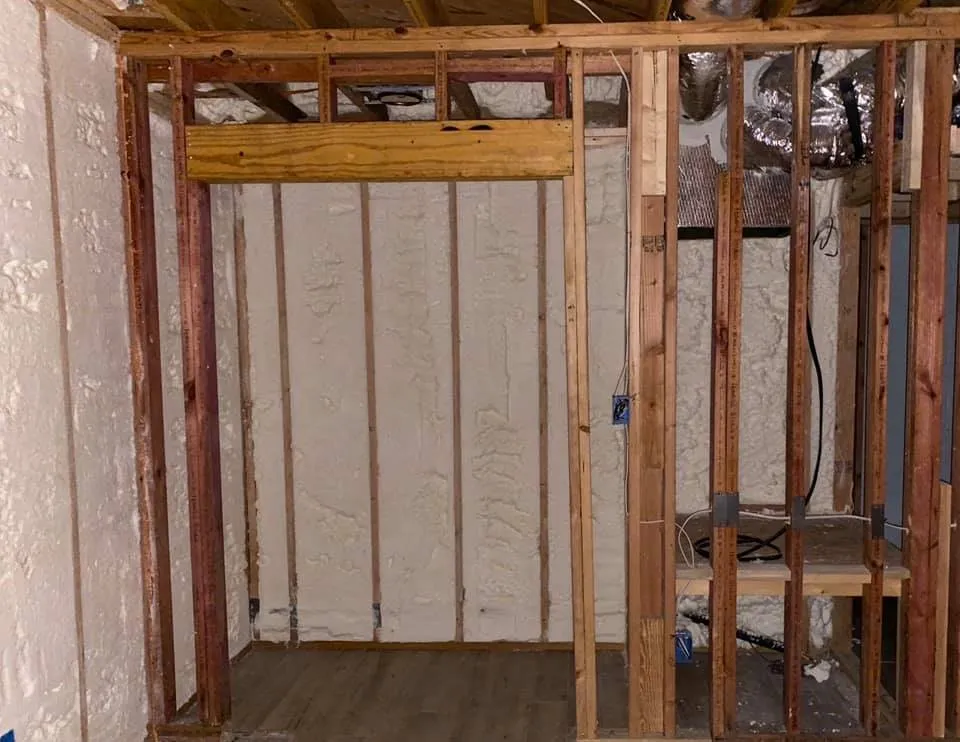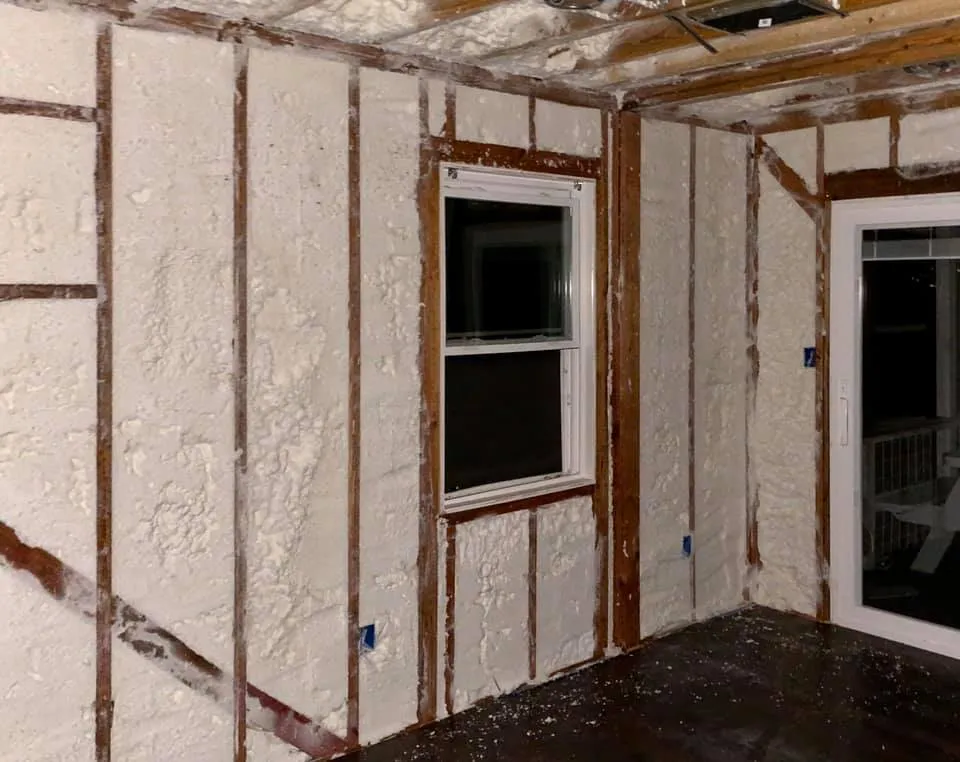Residential spray foam insulation involves chemical reactions that release gases during application. Improper handling, poor ventilation, or lack of curing time can expose occupants and installers to respiratory and skin irritation, off-gassing, or flammability risks. Understanding and planning for these issues is necessary to avoid long-term health or structural problems.
Spray foam’s effectiveness and longevity depend on correct application under suitable conditions. If sprayed in damp or improperly ventilated spaces, the foam can trap moisture or fail to cure properly. For homes in hot, humid areas like Central Texas, the risk of improper expansion and condensation buildup increases without proper thermal and vapor control strategies. The following sections provide a detailed breakdown based on Stellrr’s field experience and building science insights.
Key Safety Factors to Address First
Installer Exposure and Safety Protocols
- Use of full-face respirators and chemical-resistant gloves is non-negotiable during installation.
- Only trained, certified professionals should handle spray foam equipment.
Occupant Re-Entry Timing
- Open cell foam: Wait at least 24 hours after application.
- Closed cell foam: Wait at least 24-72 hours depending on curing conditions.
Off-Gassing and Ventilation Needs
- Fresh air exchange systems are required during and after installation.
- Improper curing may result in prolonged chemical odors and irritation.
Moisture Trapping and Wood Rot
- Installing foam over wet substrates or in humid attics can trap moisture.
- Proper moisture readings should be confirmed before application.
Bonus Tip: Infrared imaging before spraying helps verify substrate dryness and thermal bridging risks.
Comparison of Spray Foam Safety and Insulation Alternatives
| Factor | Open Cell Foam | Closed Cell Foam | Fiberglass Batt | Cellulose Blown-In |
|---|---|---|---|---|
| Application Risk | High if misapplied | High if misapplied | Low | Low |
| Chemical Exposure | Yes | Yes | No | No |
| Curing Time (Ventilation) | 24 hrs | 24-72 hrs | None | None |
| Fire Resistance (Treated) | Needs ignition barrier | Needs ignition barrier | Moderate | Moderate |
| Moisture Sensitivity | High | Low | High | High |
| Structural Reinforcement | No | Yes | No | No |
| Recommended Climate Zones | Mild climates | All climates | Dry climates | Dry climates |
Technical Properties and Handling Guidelines
| Property | Open Cell Foam | Closed Cell Foam |
|---|---|---|
| R-Value per Inch | ~3.5-3.8 | ~6.5-7 |
| Vapor Permeability | High | Low |
| Density | 0.5 lb/ft³ | 2.0 lb/ft³ |
| Expansion Rate | 100x original volume | 30-40x original volume |
| Application Temperature | 60-85°F | 60-90°F |
| Safe Re-Occupancy Time | 24 hours | Up to 72 hours |
| Thermal Bridging Prevention | Moderate | High |
Bonus Tip: In homes with HVAC ductwork in the attic, closed cell foam limits energy loss and moisture intrusion when applied directly to roof decks.
Market Facts You Should Know
- EPA research (2023) confirms that improperly applied spray foam can emit volatile organic compounds (VOCs) up to 1,000 times higher than background levels during curing.
- ASHRAE data (2024) shows that only 38% of spray foam applications meet ideal substrate moisture and temperature conditions in humid zones without professional preparation.
- NAIMA statistics indicate that non-foam alternatives still dominate retrofits (68%) due to fewer handling concerns.

Things to Consider Before Making a Decision
- Substrate Conditions: Ensure surfaces are dry and temperature-stable. Use a moisture meter.
- Application Area: Spray foam is not suitable for all cavities or historical structures without vapor analysis.
- Ventilation Strategy: Mechanical ventilation may be needed during and after installation.
- Fire Codes: Spray foam must be coated with ignition or thermal barriers in living spaces.
- Occupancy Planning: Schedule application when occupants can stay elsewhere for at least 24–72 hours.
Bonus Tip: For crawlspaces, use closed cell foam only if there is no risk of standing water or repeated flooding.
Services Stellrr Offers for Safe, Efficient Insulation
- Open Cell Insulation – Applied in interior walls and attic slopes for thermal and sound control.
- Closed Cell Insulation – High-performance envelope sealant for roof decks, crawlspaces, and basements.
- Attic Insulation – Includes prep, air sealing, and proper vapor control tailored to regional climate.
- Insulation Removal – Safe extraction of old insulation before applying spray foam.
Common Questions Before Choosing Spray Foam
How long before I can return home after installation?
24 hours minimum for open cell; up to 72 for closed cell depending on humidity and temperature.
Is spray foam safe for people with chemical sensitivities?
Only after complete curing and ventilation. Use alternative insulation if sensitivities are severe.
Can I install it in an old home?
Yes, but only after evaluating vapor drive, existing insulation, and framing condition.
What if my attic already has fiberglass?
Remove it first. Mixing materials reduces effectiveness and can cause condensation.
Get Expert Insulation Guidance
For help evaluating your home’s insulation needs and installation safety, speak with an experienced insulation contractor. Stellrr provides expert recommendations backed by field data, building science, and product-specific handling techniques.
Email: info@stellrr.com
Phone: (512) 710-2839
Frequently Asked Questions
Does spray foam shrink or crack over time?
Properly installed foam remains dimensionally stable, but incorrect ratios or substrate issues can cause defects.
Can I paint or drywall over spray foam?
Yes, but only after the foam fully cures and any required ignition barriers are applied.
Is spray foam rodent-proof?
It deters but does not eliminate pest intrusion. Gaps must still be sealed physically.
How does insulation performance change over time?
Closed cell holds R-value better than open cell. Minor aging occurs but is not significant when properly installed.
What happens if spray foam gets wet?
Closed cell resists water, but open cell absorbs it. Wet foam must be removed.

